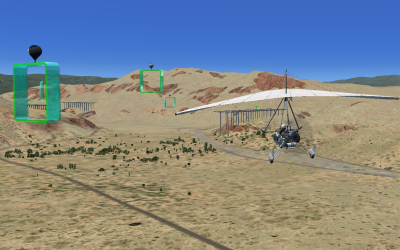


ACE
- Inspired to Soar series
What I've worked on:
What I've worked on:
•Four singleplayer missions
•One multiplayer mission
•Two gauges
•Supporting visual material (maps, charts, etc.)
•One multiplayer mission
•Two gauges
•Supporting visual material (maps, charts, etc.)
This
is a series that's designed as a foundational one - a "first steps" set
of missions for anyone learning a flight simulator. This has revisited
a lot of the
material from the "Knights in the Sky" series, only with a more contemporary setting.
The primary change in methodology here has been a focus on learning one thing and then recontextualizing it to reinforce the concept. To this end, the
missions are presented in a two-pronged fashion. The first time the player flies a mission, he will use a simplified aircraft - an ultralight, which has been
the go-to type of aircraft for beginner missions because of its simple control scheme and ease of piloting.
The player is encouraged to master the mission with the "easy" aircraft - and you see where this is going, right? We basically structuralize an "easy" and
a "hard" mode for each mission by using a simple aircraft followed by a more complex one. The mission doesn't change (effectively), but internalization
of the skills is required to succeed repeatedly in the "hard" mode, where the aircraft is less forgiving.
It's not a terribly novel concept, but it's an important one, and it works well here. Why is it important? That sort've comes back to the whole reason the
company I work for is doing these missions. The premise is that presenting a real-world scenario does two things:
1) It inspires the student by broadening the scope of what academic material is used for - it removes the "dryness" of a purely academic setting
2) It aids the student in visualizing a practical application for his knowledge - not only does it reinforce that there is a practical use, but it puts it in the context of several viable careers
That's all important, and it's a good reason for using something like aviation to teach. There's one major problem with that, though. The problem is that
- on some level - the student must perform at something that isn't implicitly academic-related to "access" the academic content. In this case, students
that don't feel as capable piloting an aircraft likely won't have as beneficial an experience as those who do.
Therefore, the import of the easy/hard presentation is this - it helps to remove the effect of player skill as it relates to the game-like elements. When a player flies the mission the second (or third, etc.) time, he is strictly being tested on his acquisition of the academic knowledge (e.g. understanding of
pitch and power) and not on his ability to perform (e.g. handiness with a joystick).
material from the "Knights in the Sky" series, only with a more contemporary setting.
The primary change in methodology here has been a focus on learning one thing and then recontextualizing it to reinforce the concept. To this end, the
missions are presented in a two-pronged fashion. The first time the player flies a mission, he will use a simplified aircraft - an ultralight, which has been
the go-to type of aircraft for beginner missions because of its simple control scheme and ease of piloting.
The player is encouraged to master the mission with the "easy" aircraft - and you see where this is going, right? We basically structuralize an "easy" and
a "hard" mode for each mission by using a simple aircraft followed by a more complex one. The mission doesn't change (effectively), but internalization
of the skills is required to succeed repeatedly in the "hard" mode, where the aircraft is less forgiving.
It's not a terribly novel concept, but it's an important one, and it works well here. Why is it important? That sort've comes back to the whole reason the
company I work for is doing these missions. The premise is that presenting a real-world scenario does two things:
1) It inspires the student by broadening the scope of what academic material is used for - it removes the "dryness" of a purely academic setting
2) It aids the student in visualizing a practical application for his knowledge - not only does it reinforce that there is a practical use, but it puts it in the context of several viable careers
That's all important, and it's a good reason for using something like aviation to teach. There's one major problem with that, though. The problem is that
- on some level - the student must perform at something that isn't implicitly academic-related to "access" the academic content. In this case, students
that don't feel as capable piloting an aircraft likely won't have as beneficial an experience as those who do.
Therefore, the import of the easy/hard presentation is this - it helps to remove the effect of player skill as it relates to the game-like elements. When a player flies the mission the second (or third, etc.) time, he is strictly being tested on his acquisition of the academic knowledge (e.g. understanding of
pitch and power) and not on his ability to perform (e.g. handiness with a joystick).